3.2 General EPA proposal for USA coastal waters
The latest proposal from the EPA is to extend the scope of application of the EPA off-highway emission standards to also apply to marine engines.
Proposed limits:
NOx: 9.2 g/kWh
CO: 11.4 g/kWh
HC: 1.3 g/kWh
Particulates: 0.54 g/kWh
Attainment of the CO and HC values should not cause any problems. "LOW NOx Combustion" and "Direct Water Injection" technologies are available for reducing NOx emissions, if necessary to 9.2 g/kWh. To comply with the requirements for particulates a low-sulphur fuel should be used, i.e. distillate fuel, when operating in USA coastal waters/harbours.
As described, three different proposals have been suggested for regulating the marine emissions in USA coastal waters. All these proposals are still under debate, consequently, the exact NOx limits, the date of implementation, test procedures, type of proposal to be adopted, etc., are not yet determined.
4. Measures to comply with regional NOx requirements
4.1 Adjustable fuel injection timing

4.2 Introducing Water
Introducing water into the combustion process reduces NOx formation. Factors influencing the suppression of NOx formation are:
・Reduction of the partial pressure of oxygen in combustion by introducing water.
・Reduction of heat load due to the energy consumed by the evaporating process.
4.2.1 Water-in-fuel emulsions for c. 20% NOx reduction
The use of water-in-fuel emulsion is one method of introducing water. The NOx reduction potential of this method is only about 20%, due to a maximum water/fuel ratio of about 0.3. The implementation of this technique requires a high-capacity fuel handling system on-the engine to maintain unaffected power output (Fig. 5).
Drawbacks:
・Water-in-fuel emulsions are not stable when using distillate fuel, thus limiting the use of this method in SOx restricted areas.
・The fuel injectors need to be optimized for a high fluid flow-through, resulting in poor performance of the engine when the water introduction is shut-off.